The recliner is an innovated development to the classic wheelchair. Reclining wheelchairs have been designed for people with health conditions like hip extension contractures and a type of low blood pressure known as orthostatic hypotension. People who have hip and back injuries can also find relief with wheelchairs that recline. These types of wheelchairs are additionally beneficial for people who want some additional comfort and alleviate some of the stress from the back, neck and other parts of the body.
Reclinable wheelchair models come with secure headrests and are generally lighter in weight than other types of wheelchairs. Headrests can feature side padding to hold the head better in place for additional security. Chairs also come with leg rests that can be raised together or individually to elevate a single leg. Armrests on certain types can be removed while others stay attached to the chair. Some models have narrower seats while others have wider seats to accommodate larger individuals or people who need more room to feel comfortable. There are chairs available that can be manually operated by people who still have full use of their arms while others require a caregiver to push for movement. Many standard, transport and power wheelchairs are also designed with reclining capabilities.
Reclining Wheelchairs Models
The best reclining wheelchair models come with many features that make sitting, reclining and getting around much less arduous. These chairs are useful for improving the lives of seniors, people who have suffered accidents and other individuals with physical challenges.
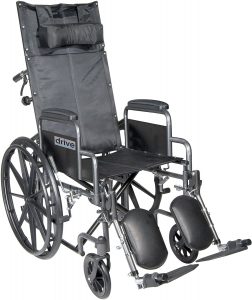
With its detachable desk-length armrests and elevating supports for the legs, this chair is one of the most versatile and adaptive models. The rest supports for each arm can also be extended when the chair is reclined. Up to 180 degrees of adjustments can be made. The frame that is built from durable carbon steel with a silver vein finish does not require a lot of extra work to maintain and can hold riders securely. Lightweight Mag-style wheels are attached to the chair to travel over uneven surfaces with less difficulty. For additional safety, the wheels have been set back farther on the frame to prevent the chair from tipping. The seat can support up to 300 pounds and has a width of 18 inches.

People who want high-quality cushioning for the upper body will appreciate the padded headrest on this model. A 20-inch wide seat and 300-pound weight capacity are ideal for different body types. The triple-coated chrome finish on the frame made of carbon steel is intended to prevent any chipping. Naugahyde upholstery is used to cover the back and seat for easy cleaning and maintenance. Front casters measuring 8 inches allow for smooth steering and turns. Additional safety is provided by the chair’s rear anti-tippers and the wheel locks that can be pushed to lock. The foot plates are made from aluminum that won’t crack. Leg rests that swing away can easily be adjusted to the desired height.
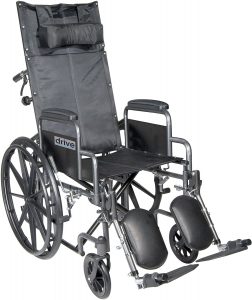
The front and rear precision wheel bearings on the frame help give this chair greater longevity. A cushioned neck immobilizer provides additional stability. Chair options include seats that measure 16, 18 or 20 inches wide to accommodate people of all body types. The push-to-lock wheel brakes are able to stop the chair from moving without putting anyone in danger. Numerous adjustments can be achieved thanks to the chair’s hydraulic reclining mechanism. A chair with a 20-inch wide seat has a weight capacity of 350 pounds while the 18- and 16-inch seats can hold up to 300 pounds.
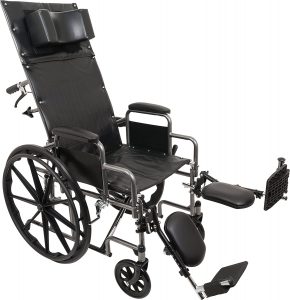
Noted for its strength and durability in many reclining wheelchair reviews, this chair is made with a setback model position to keep the chair from falling over when it is fully reclined. Reclining options range from 90 to 160 degrees. The vinyl upholstery that covers much of the chair is resistant to bacteria and mildew and can be cleaned with little hassle. Seat width sizes range from 16 to 22 inches. The chair’s backrest can also be extended to increase its length, making this model one of the best high back wheelchair options on the market. Riders who wish to move the chair manually themselves can use the composite hand rims on the 24-inch solid urethane tires.
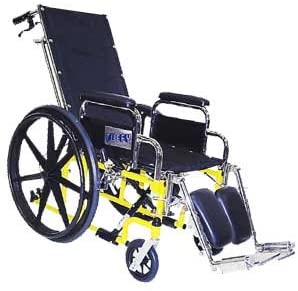
Manufactured by Tuffcare, this tilt back wheelchair is ideal for children and comes with seat width sizes ranging from as wide as 16 inches to as narrow as 12 inches for small children. Green and yellow color choices are available for the frame. The black vinyl upholstery is flame-resistant and easy to clean. Optional brake extensions can be added onto the chair for extra safety. The 5- by 1-inch caster wheels and 20- by 1-inch rear molded wheels include hard rubber tires that can travel across different surfaces. The detachable desk armrests and triple chrome-plated frame offer additional convenience.
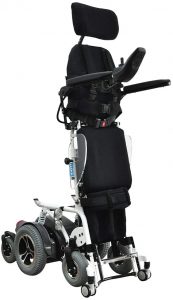
This electric tilting wheelchair can be fully reclined and raised to a stand-up position to assist people who have difficulty standing on their own. The DX2 dynamic controller features an easy-to-operate LED display. LED headlights are included to increase visibility in darker settings. The H-shaped safety harness helps prevent people from falling out of the chair. A 30-inch turning radius makes this reclining wheelchair easier to maneuver. The seat can be adjusted to different depths, and the legs can be adjusted to different lengths. Six different sizes are available, and each chair comes with either a right- or left-hand side controller. To make traveling over rough terrains easier, a spring suspension is included.
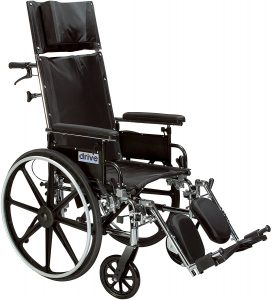
Healthcare professionals often find this high back reclining wheelchair to be useful for patients who need seats that are 16 to 20 inches wide. Depending on the specific size chosen, the wheelchair itself weighs 48 to 51 pounds and can accommodate people who weigh up to 250 pounds. The headrest is mounted on extended tubes to make sleeping while reclining easier. Deluxe nylon has been added for the seat. A mag lock system is used for the reclining positioning that can be adjusted to up to 180 degrees.
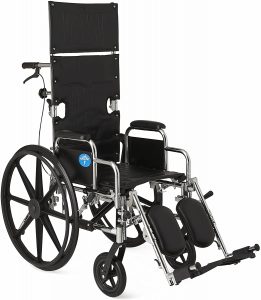
Designed for optimal patient safety and mobility, this chair has a 22-inch high back with a 10-inch removable headrest. Elevated leg rests and tilt-in-space features are also included. The seat can be adjusted to a hemi level thanks to the chair’s hemi axle. Seat size options include 16 by 17, 18 by 17, and 20 by 17 inches. At 45 pounds, this model is one of the lighter recliner wheelchair options available. Most people who weigh up to 350 pounds will find this wheelchair suitable. An anti-fold device can be added to the chair to keep it from folding while a person sits in it.
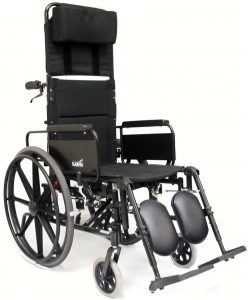
This fully customizable wheelchair is also one of the more budget-friendly options on the market. Weight capacity ranges from 250 to 350 pounds, and the seat width can range between 16 and 20 inches depending on the selected size. A 180-degree reclining range makes this chair a great choice for both sitting and sleeping. The full-length armrests can be removed to allow for more upper body room and to save space when the chair is in storage. Side panels and anti-slip footplates also help make this chair one of the top-rated selections.
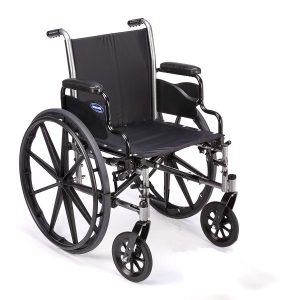
With five different seat width options and a carbon steel frame that can hold up to 250 pounds, the Invacare Tracer SX5 Recliner can meet many people’s needs. A pair of 24-inch caster wheels and composite casters make getting around easier. Reclining ranges from 100 to 168 degrees. A high back on the chair is suitable for taller individuals. Swing-away footrests keep the feet from dragging while the chair is in motion. The chair even comes with a removable pillow to give the neck area more cushioning.
How To Choose A Reclining Wheelchair
When shopping for a reclining wheelchair, the following factors should be considered in order to make the best choice:
- Chair Body and Seat Width Size
A reclining wheelchair should be tall enough and have enough seat width size for a person to sit and lay back comfortably. Many chairs range from 31 to 50 inches in height and have seat widths that are between 16 and 20 inches.
- Weight
The wheelchair should be sturdy enough to accommodate the weight of the rider, but it is also important to get a chair that is not too heavy to maneuver. Even though recliner wheelchairs are generally heavier than other types and may weigh over 60 pounds, it is possible to find options that weigh under 10 pounds. Chairs are made for total weight capacities of 250 to 400 pounds.
- Reclining Features
People who plan to sleep a lot in their chairs will want a model that can lay back completely to allow the body to be in a flat position. A chair that reclines a full 180 degrees will put the upper body and legs in an optimal position for sleeping. Individuals who can walk but still have difficulty rising to their feet from a sitting position can benefit from getting a recliner that also has stand-up assistance features.
- Upholstery
The upholstery on the seat and back can make the difference in feeling the most comfortable. Naugahyde, vinyl and nylon are among the most common types of upholstery used on these chairs. Upholstery that is resistant to bacterial growth and fire will also be an excellent choice.
- Wheels
Larger rear wheels are ideal for riders who want to manually move their wheelchairs themselves, and wheels measuring 24 by 1 inches usually serve this purpose. The rear wheels along with the front casters should allow smooth turns and steering and be able to travel across various surfaces without getting stuck or rolling the chair off course.
- Headrest
To ensure the most relaxation while sitting and sleeping, a sturdy headrest that has enough cushioning will be ideal. Some headrests can be removed for easy cleaning and storage. A headrest with side supports can help people who have neck injuries or limited movement keep their heads in place while the chair is moving.
- Armrests
Armrests that are padded and can extend can give people more stability as they sit and sleep. Some wheelchairs also come with armrests that can be removed.
- Footrests
Footrests that are comfortable for the feet and can be moved easily when exiting or sitting down in the chair are practical for both patients and caregivers. Extra padding for the backs of the legs can keep the limbs even more stable and comfortable.
- Braking
Reliable brakes will be essential for stopping the chair from steering out of control. Brakes with locking mechanisms can keep the chair from rolling when people are trying to stand up and get into their chairs. Locking brakes can also prevent sudden and unexpected movements of the chair when a person is trying to sleep while reclining. When being applied, the brakes should be able to bring the chair to a stop without any jerking motions that may cause physical harm to the rider.